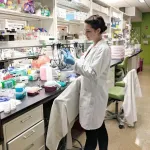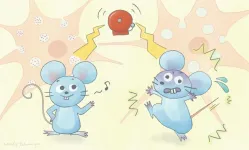(Press-News.org) BOSTON - Some police departments in the United States continue to teach officers that neck restraints are a safe method for controlling agitated or aggressive people, but that's a dangerous myth, according to a Viewpoint written by three neurologists at Massachusetts General Hospital (MGH) in JAMA Neurology.
The killing of George Floyd, a Black man who died while being arrested in May 2020 after a police officer pressed a knee to his neck for more than eight minutes, helped spark a national conversation about racial injustice in the United States. Floyd's death made headlines, as did that of Eric Garner in 2014 after police placed him in a chokehold. Yet a number of other Americans have died during confrontations with police officers who used neck restraints, says MGH neurologist Altaf Saadi, MD, senior author of the Viewpoint column.
Along with coauthors Jillian M. Berkman, MD, and Joseph A. Rosenthal, MD, PhD, Saadi was disturbed by the use of neck restraints by police departments in the United States. They found that some prohibit chokeholds and other neck restraints, but others teach the techniques for the purpose of subduing allegedly uncooperative people during encounters. Notably, some police agencies advise that carotid restraint--compressing the two large blood vessels on either side of the neck, which is known as a stranglehold--is a safe, nonlethal tactic that temporarily renders a person unconscious by reducing blood flow to the brain.
"As a neurologist, I know that there is never a scenario where stopping the flow of blood and oxygen to the brain is medically appropriate," says Saadi. "What shocked me most was that much of the literature supporting these techniques hides behind medical language, but lacks a real understanding of the pathophysiology of the significant harm they cause to an individual. As neurologists, we are taught that 'time is brain,' because there's such a rapid loss of human nervous tissue when the flow of blood and oxygen to the brain is reduced or stopped."
In their Viewpoint, Saadi and her colleagues describe how carotid compression--which can occur with as few as 6 kilograms (13 pounds) of force, or about the weight of a typical house cat--can result in stroke, seizure and death. They call for the creation of a system for reporting on law enforcement's use of neck restraints, including how often the technique is used and if it results in death or disability.
"It's in the public's best interest to have this data," says Saadi. She believes that increasing awareness about the impact of neck restraints could help curb their use. Ultimately, says Saadi, there is no medical justification for neck restraints in policing.
INFORMATION:
Altaf Saadi, MD, is also an instructor in neurology at Harvard Medical School. Jillian M. Berkman, MD, is a resident physician at Brigham and Women's Hospital. Joseph A. Rosenthal, MD, PhD, is a resident physician at MGH.
About the Massachusetts General Hospital
Massachusetts General Hospital, founded in 1811, is the original and largest teaching hospital of Harvard Medical School. The Mass General Research Institute conducts the largest hospital-based research program in the nation, with annual research operations of more than $1 billion and comprises more than 9,500 researchers working across more than 30 institutes, centers and departments. In August 2020, Mass General was named #6 in the U.S. News & World Report list of "America's Best Hospitals."
Certain bacteria, known as plant-growth-promoting bacteria (PGPB), can improve plant health or protect them from pathogens and are used commercially to help crops. To further improve agricultural yields, it is helpful to identify factors that can improve PGPB behavior.
Many PGPB form sticky communities of cells, known as biofilms, that help them adhere to plant roots. A group of scientists in North Carolina and Massachusetts were interested in finding other plant-associated bacteria that could help PGPB better adhere to plant roots, with the hope that increasing the number of PGPB cells attached to roots would increase their beneficial activities. ...
Scripps Institution of Oceanography at UC San Diego researchers have uncovered how rain and waves act on different parts of coastal cliffs.
Following three years of cliff surveys in and near the coastal city of Del Mar, Calif., they determined that wave impacts directly affect the base, and rain mostly impacts the upper region of the cliffs.
The study appears in the journal Geomorphology and was funded by California State Parks. California's State Parks Oceanography program supports climate adaptation and resilience efforts through coastal and cliff erosion observations and modeling, ...
Below please find a summary and link(s) of new coronavirus-related content published today in Annals of Internal Medicine. The summary below is not intended to substitute for the full article as a source of information. A collection of coronavirus-related content is free to the public at http://go.annals.org/coronavirus.
1. Review concludes universal mask use by lay persons reduces the spread of viral infections including SARS-CoV-2
Findings affirm policy promised by President-Elect Biden, who will ...
What The Study Did: This study identified racial/ ethnic, sex, age, language, and socioeconomic differences in accessing telemedicine for primary care and specialty ambulatory care; if not addressed, these differences may compound existing inequities in care among vulnerable populations.
Authors: Srinath Adusumalli, M.D., M.Sc., of the Hospital of the University of Pennsylvania in Philadelphia, is the corresponding author.
To access the embargoed study: Visit our For The Media website ...
What The Study Did: Severe COVID-19 is characterized by the intense formation of neutrophil extracellular traps (NETs), leading to the blockage of microvessels, as shown in pulmonary samples. The occurrence of ST-elevated myocardial infarction (STEMI) is a serious cardiac manifestation of COVID-19; the intrinsic mechanism of coronary thrombosis appears to still be unknown. This case series report of five patients sought to determine the role of NETs in coronary thrombosis in patients with COVID-19.
Authors: Ana Blasco, M.D., Ph.D., of the Hospital Universitario Puerta de Hierro-Majadahonda in Madrid, Spain, is the corresponding ...
In 1986, cellular biochemist Kazumitsu Ueda, currently at Kyoto University's Institute for Integrated Cell-Material Sciences (iCeMS), discovered that a protein called ABCB1 could transport multiple chemotherapeutics out of some cancer cells, making them resistant to treatment. How it did this has remained a mystery for the past 35 years. Now, his team has published a review in the journal FEBS Letters, summarizing what they have learned following years of research on this and other ATP-binding cassette (ABC) transporter proteins.
ABC transporter proteins are very similar across species and have various ...
Scientists have suspected mutations in a cellular cholesterol transport protein are associated with psychiatric disorders, but have found it difficult to prove this and to pinpoint how it happens. Now, Kazumitsu Ueda of Kyoto University's Institute for Integrated Cell-Material Sciences (iCeMS) and colleagues in Japan have provided evidence that mice with disrupted ABCA13 protein demonstrate a hallmark behaviour of schizophrenia. The team investigated ABCA13's functions and published their findings in the Journal of Biological Chemistry.
ABCA13 belongs to a family of cellular transporter proteins called ATP-binding ...
Philadelphia, December 29, 2020 - Posttraumatic stress disorder (PTSD) is a complex psychiatric disorder brought on by physical and/or psychological trauma. How its symptoms, including anxiety, depression and cognitive disturbances arise remains incompletely understood and unpredictable. Treatments and outcomes could potentially be improved if doctors could better predict who would develop PTSD. Now, researchers using magnetic resonance imaging (MRI) have found potential brain biomarkers of PTSD in people with traumatic brain injury (TBI).
The study appears in ...
What happens in the brain when our conscious awareness fades during general anesthesia and normal sleep? Finnish scientists studied this question with novel experimental designs and functional brain imaging. They succeeded in separating the specific changes related to consciousness from the more widespread overall effects, and discovered that the effects of anesthesia and sleep on brain activity were surprisingly similar. These novel findings point to a common central core brain network fundamental for human consciousness.
Explaining the biological basis of human ...
A fascinating substance with unique properties, ice has intrigued humans since time immemorial. Unlike most other materials, ice at very low temperature is not as ordered as it could be. A collaboration between the Scuola Internazionale Superiore di Studi Avanzati (SISSA), the Abdus Salam International Centre for Theoretical Physics (ICTP), the Institute of Physics Rosario (IFIR-UNR), with the support of the Istituto Officina dei Materiali of the Italian National Research Council (CNR-IOM), made new theoretical inroads on the reasons why this happens and on the way in which some of the missing order can be recovered. In that ordered state the team ...



